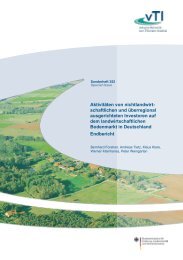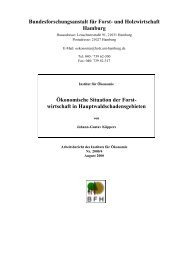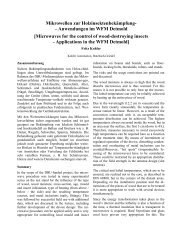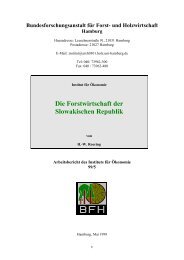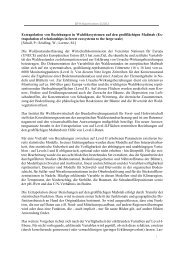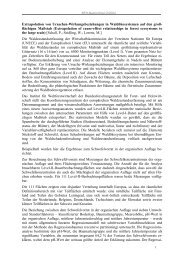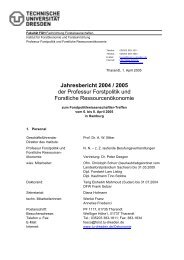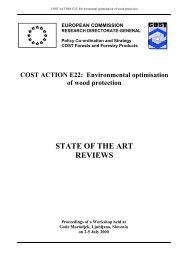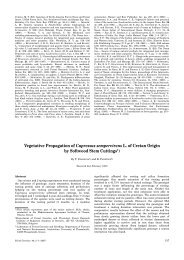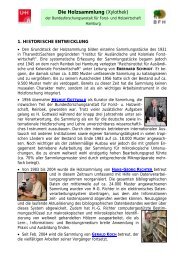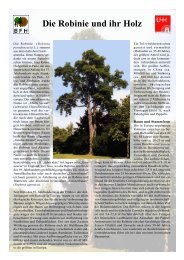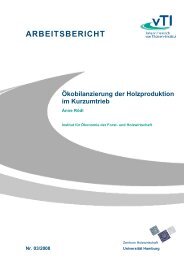Landbauforschung vTI Agriculture and Forestry ... - 1. Januar 2008
Landbauforschung vTI Agriculture and Forestry ... - 1. Januar 2008
Landbauforschung vTI Agriculture and Forestry ... - 1. Januar 2008
You also want an ePaper? Increase the reach of your titles
YUMPU automatically turns print PDFs into web optimized ePapers that Google loves.
A. Schwabe, U. Meyer, G. Flachowsky, S. Dänicke / <strong>L<strong>and</strong>bauforschung</strong> - <strong>vTI</strong> <strong>Agriculture</strong> <strong>and</strong> <strong>Forestry</strong> Research 3 2012 (62)129-136 135<br />
group (A) showed the highest total feed intake but these<br />
observed differences were not significant (Table 6). Similar<br />
results were observed for the crude protein <strong>and</strong> metabolizable<br />
energy intake. The averaged daily weight gain over<br />
all treatment groups amounted to 988 ± 77 g <strong>and</strong> was in<br />
normal ranges for female calves of this age. However, due<br />
to reduced feed intake the calves of Group D showed a<br />
slightly but not significantly lower daily weight gain than<br />
the other groups. The calculated feed-to-gain ratio <strong>and</strong><br />
ME-to-gain ratio also remained unaffected by the dietary<br />
treatments.<br />
4 Discussion<br />
These two experiments were conducted to test whether<br />
age <strong>and</strong> gender play a role regarding efficiency of REE<br />
on feed intake <strong>and</strong> performance parameter. The nutrient<br />
composition <strong>and</strong> energy content of the milk replacer <strong>and</strong><br />
concentrates, as shown in Table 3 <strong>and</strong> 4, were comparable<br />
between dietary treatments. As already extensively<br />
discussed by Schwabe et al. (2011), REE are occurring<br />
ubiquitously, therefore they were also detected in roughage<br />
<strong>and</strong> concentrate used in experiment 1 <strong>and</strong> 2 of the<br />
control group.<br />
The health state of calves was not impaired by the REE<br />
application as reported by different research groups in<br />
feeding experiments with broilers (He et al., 2010) pigs<br />
(Förster et al., <strong>2008</strong>), calves (Miller, 2006) <strong>and</strong> fattening<br />
bulls (Schwabe et al., 2011), before. In experiment 1,<br />
diarrhoea <strong>and</strong> respiratory diseases were diagnosed <strong>and</strong><br />
treated, but a relation to REE supplementation was not<br />
observed. These diseases are the two most common diseases<br />
that occur in young calves.<br />
The birth weight of male calves was higher than that<br />
of female calves (data not shown). This result is similar<br />
to reports of various authors (Kertz et al., 1997; Junge et<br />
al., 2003), who also found verifiable differences of similar<br />
magnitude among different gender. For this reason, the<br />
male calves were 10.5 % <strong>and</strong> 8.1 % heavier at the beginning<br />
<strong>and</strong> the end of the first trial (Table 5). With regard<br />
to the age of the piglets, some of the preliminary studies<br />
suggested, that the effect of performance enhancement<br />
of REE is better feasible in newly weaned than in older<br />
animals under the optimized conditions of European piglet<br />
production (He <strong>and</strong> Rambeck, 2000; Knebel, 2004; Kraatz<br />
et al., 2006). To our knowledge, Meyer et al. (2006) are the<br />
sole authors, whom up to now studying the influence of<br />
dietary REE supplementation (200 mg REE-citrate/kg milk<br />
replacer) on feed intake <strong>and</strong> performance of female pre-ruminant<br />
calves for a period of 6 weeks. Following this study,<br />
we used in the experiment 1, the same feed, dose <strong>and</strong><br />
additives, however with both gender <strong>and</strong> a higher number<br />
of animals. We observed, that the REE treated calves<br />
consumed numerically lower concentrate (42 g/d), which<br />
mainly resulted from the male calves, however, no interaction<br />
between group <strong>and</strong> sex was observed (p = 0.291; Table<br />
5). Furthermore, the supplementation of REE reduced<br />
grass hay intake, resulting in lower total DMI in REE group<br />
(-7.9 %) versus control group. However, the individual<br />
grass hay intake could not be recorded for technical reasons.<br />
This finding is supported by the results of the above<br />
mentioned authors (Meyer et al., 2006), who also found a<br />
decreased total DMI of -7.8 % as a result of reduced hay<br />
intake (-44 %), while no differences were observed either<br />
in the milk replacer intake (553 g/d in the control group<br />
versus 560 g/d) nor in the concentrate intake (156 g/d in<br />
the control group versus 161 g/d). In a more recent longterm<br />
study with growing bulls Schwabe et al. (2011) reported<br />
a significant linear decrease in the grass hay intake<br />
from 0.55 to 0.31 kg/d during the growing period (119 to<br />
180 kg LW) as well as in the maize silage intake from 6.09<br />
to 5.44 kg/d during the fattening period (180 to 556 kg<br />
LW) after the supplementation of 0, 100, 200 <strong>and</strong> 300 mg<br />
REE-citrate/kg diet. In the present experiment, the increasing<br />
REE-citrate supplementation to the diet of growing<br />
female calves had no significant effect on the feed intake<br />
but a numerally reduction in the feed intake was also detectable<br />
(Table 6). The reason for the often observed reduction<br />
in the feed intake of cattle, as described above,<br />
induced by REE supplementation with the exception of the<br />
investigation of Schwabe et al. (2009) is unclear. However,<br />
it is well known that REE have many similarities to the element<br />
calcium in size, bonding as well as in coordination<br />
geometry <strong>and</strong> donor atom preference which enables them<br />
to compete with the calcium ions (Evans, 1990; Redling,<br />
2006). On this basis, it was described that REE can replace<br />
calcium ions at superficial membranes sites <strong>and</strong> prevented<br />
calcium ions uptake to less accessible calcium ions sites<br />
in smooth muscles <strong>and</strong> the muscle contraction is thereby<br />
inhibited (Weiss <strong>and</strong> Goodman, 1969; Weiss, 1974; Triggle<br />
<strong>and</strong> Triggle, 1976; Redling, 2006). This in turn can alter the<br />
gastrointestinal motility which may decrease the passage<br />
rate <strong>and</strong> therefore affect the feed intake. A second explanation<br />
may be an effect on nervous system as feed intake<br />
<strong>and</strong> gastrointestinal motility are controlled via the vegetative<br />
nervous system. Since previous studies have demonstrated<br />
that lanthanoide showed a variety of actions on<br />
nerve cells <strong>and</strong> most of them are related to the interaction<br />
with Ca 2+ involved transport processes such as inhibition of<br />
calcium binding to synaptosomal membranes (Basu et al.,<br />
1982) <strong>and</strong> inhibition of calcium-dependent neurotransmitter<br />
release (Przywara et al., 1992). It was also observed<br />
that lanthanum can influence the neural release of serotonin<br />
(Stefano et al., 1980).<br />
The slightly decrease in feed intake of the REE treated<br />
calves was reflected in the live weight gain in both ex-



